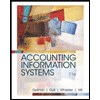
a)
To explain: The three effectiveness goals.
Introduction:
OE/S process:
It is known as the order entry/sales process. It describes the first four steps of the order-to-cash process.
b)
To explain: The particular resources that need to be secured.
Introduction:
OE/S process:
It is known as the order entry/sales process. It describes the first four steps of the order-to-cash process.
c)
To explain: The two data inputs in the system.
Introduction:
OE/S process:
It is known as the order entry/sales process. It describes the first four steps of the order-to-cash process.
d)
To explain: A valid sales order and shipping notice.
Introduction:
OE/S process:
It is known as the order entry/sales process. It describes the first four steps of the order-to-cash process.
Want to see the full answer?
Check out a sample textbook solution
Chapter 10 Solutions
Bundle: Accounting Information Systems, Loose-Leaf Version, 11th + MindTap Accounting, 1 term (6 months) Printed Access Card
- What is the full form of "YTD"? a.Yield of Divergence b.Year to Delivery c.Year-to-date d.Yield to Debitarrow_forwardQuestion Three A company needs $10,000 in 5 years to replace a piece of equipment. How much must be invested now at an interest rate of 8% p.a. compounded daily in order to provide for this replacement?arrow_forwardYear Free Cash Flow (FCF) 0 -$17,000,000 1 $4,980,000 2 $4,980,000 3 $4,980,000 4 $4,980,000 5 $6,980,000 The Net Present Value at a discount rate of 15%: Present Value (PV) for each year: PV(Year 1) = $4,980,000 ÷ (1 + 0.15)^1 = $4,330,435. PV(Year 2) = $4,980,000 ÷ (1 + 0.15)^2 = $3,765,590. PV(Year 3) = $4,980,000 ÷ (1 + 0.15)^3 = $3,274,426. PV(Year 4) = $4,980,000 ÷ (1 + 0.15)^4 = $2,847,328. PV(Year 5) = $6,980,000 ÷ (1 + 0.15)^5 = $3,477,617. Sum of PVs = $4,330,435 + $3,765,590 + $3,274,426 + $2,847,328 + $3,477,617 = $17,695,396. Initial Investment = $17,000,000. NPV = Total PV - Initial Investment = $17,695,396 - $17,000,000 = $695,396. Calculate The Internal Rate of Returnarrow_forward
- Financial leverage is also known as a.Trading on equity b.Trading on debt c.Interest on debt d.Interest on equityarrow_forwardThe variability in return on security due to changes in the level of interest rate in market is called as: a.Interest Risk b.Financial risk c.Call Risk d.Liquidity Riskarrow_forwardCurrent return is the ratio of annual income to: a.Difference between beginning price and ending price of security b.Total beginning price and ending price of security c.Beginning price of security d.Ending price of securityarrow_forward
 Accounting Information SystemsAccountingISBN:9781337619202Author:Hall, James A.Publisher:Cengage Learning,
Accounting Information SystemsAccountingISBN:9781337619202Author:Hall, James A.Publisher:Cengage Learning, Cornerstones of Cost Management (Cornerstones Ser...AccountingISBN:9781305970663Author:Don R. Hansen, Maryanne M. MowenPublisher:Cengage Learning
Cornerstones of Cost Management (Cornerstones Ser...AccountingISBN:9781305970663Author:Don R. Hansen, Maryanne M. MowenPublisher:Cengage Learning Auditing: A Risk Based-Approach to Conducting a Q...AccountingISBN:9781305080577Author:Karla M Johnstone, Audrey A. Gramling, Larry E. RittenbergPublisher:South-Western College Pub
Auditing: A Risk Based-Approach to Conducting a Q...AccountingISBN:9781305080577Author:Karla M Johnstone, Audrey A. Gramling, Larry E. RittenbergPublisher:South-Western College Pub Auditing: A Risk Based-Approach (MindTap Course L...AccountingISBN:9781337619455Author:Karla M Johnstone, Audrey A. Gramling, Larry E. RittenbergPublisher:Cengage Learning
Auditing: A Risk Based-Approach (MindTap Course L...AccountingISBN:9781337619455Author:Karla M Johnstone, Audrey A. Gramling, Larry E. RittenbergPublisher:Cengage Learning Accounting Information SystemsFinanceISBN:9781337552127Author:Ulric J. Gelinas, Richard B. Dull, Patrick Wheeler, Mary Callahan HillPublisher:Cengage Learning
Accounting Information SystemsFinanceISBN:9781337552127Author:Ulric J. Gelinas, Richard B. Dull, Patrick Wheeler, Mary Callahan HillPublisher:Cengage Learning




